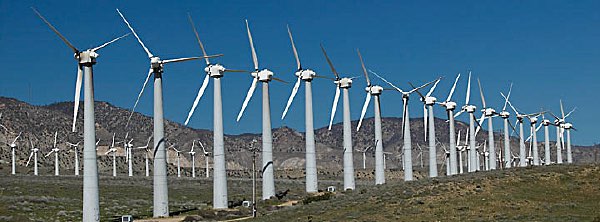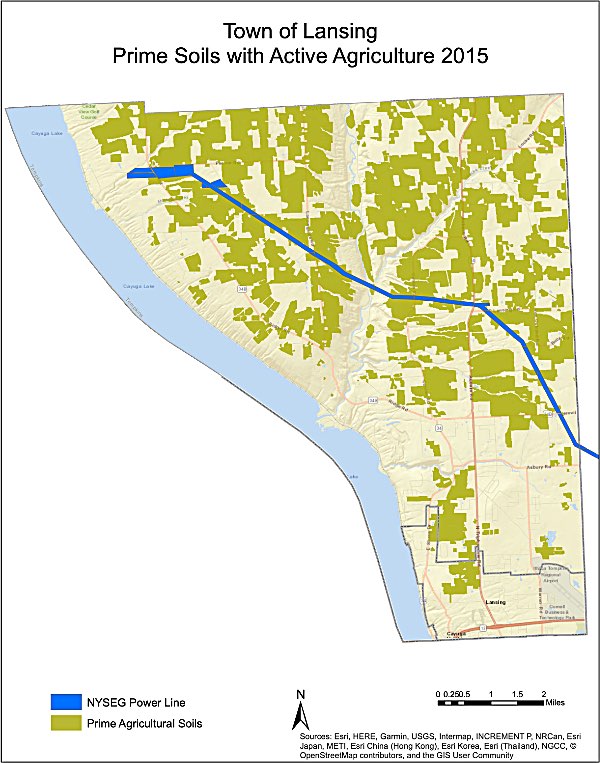- By Dan Veaner
- News
 Print
Print 
After many months of editing and discussion, and a brief public hearing, the Lansing Town Board unanimously passed a Solar and Wind Energy law at its July meeting (7/15). The law amends Lansing's Land use Ordinance that relates to solar and wind energy systems that are planned for sites in the Town. One of the recurring concerns as the law was being crafted was to protect prime farmland, which is part of the best locations in the Town for solar arrays along existing power lines that were installed for electricity delivery by the now-closed Cayuga Power Plant. Board members had considered a 10-acre limit, and considered it again when Tompkins County included it among tits comments on the law.
But Town Attorney Guy Krogh noted that developers could get around a 10-acre provision by submitting several 9.9 acre applications, and said any larger solar far that is proposed is likely to be more than 10 acres.
"Even a small community solar system will be more than 10 acres," he said. "The average small system is 12 to 14 acres. So this 10 acre limit doesn't make any sense. So at the end of the day, it comes down to what is the appropriate policy and what is the need of the town of Lansing?"
While no limit on acreage for ended up in the law, Lansing Director of Planning C.J. Randall said there are protections for farmland in the final draft.
"As part of the site planning tools specifically the new section 802.18.7 actually specifically addresses soils on prime farmland or land of statewide importance," said Randall. "And there was the requirement to have native vegetation to attract pollinators. This allows the Planning Board to specify freestanding ballast or racking systems in areas they think would be most beneficial. Also there should be a top soil plan for the area, for the project itself. We also have a strong storm water controls as part of project review as well."
Section 802.18.7 says, "Soils. Solar Energy Systems sited on Prime Farmland or Farmland of Statewide Importance may be required to seed up to twenty percent (20%) of the total surface area of panels on the lot with native perennial vegetation designed to attract pollinators. The Planning Board may specify free-standing ballast or racking systems. All topsoil will be stockpiled immediately adjacent to the area where stripped/ removed and shall be used for restoration on that particular site. No topsoil shall be removed from the site. The Site Plan shall clearly designate topsoil stockpile areas in the field and on the construction drawings."
After discussion Supervisor Ed LaVigne said the Planning Board would have discretion to protect prime soil and farmland when considering applications for larger solar farms.
"At least now from the conversation, I think that's where we want to go with this for the Planning Board," LaVigne said. "This is what our goal is. When, when possible, try to avoid the fine soil. In some cases we can't because of these certain criteria you'll have to be on prime soils."
"The planning board's job is to take conflicting desires and work the medium between them," said Councilman Joseph Wetmore.
The Board also considered farmers' right to use their land as they see fit. At a time when small farms are struggling, leasing land to solar companies is one way to make the land profitable. Councilwoman Andra Benson, whose family owns a large dairy farm in Lansingville, said it would be nice to designate poor farmland for solar, though not necessarily feasible.
 Land around existing powerlines define the best locations for solar farms in Lansing
Land around existing powerlines define the best locations for solar farms in Lansing"It's a pretty hard decision being a farmer, whith what you're going to do with your land, especially if you're not profitable. But I do know the closer you get to the Lake, the less land there is. It's rocky slopes. Wouldn't it be nice if there was a whole swath that we can say 'that's really crummy farm land. Let's see if we could put that into solar'... but it isn't always practical. And the people who own that land, from my experience, usually want help with taxes."
Only one resident, Patrick Higgins, spoke up at the public hearing that preceded the vote, asking whether the law would help him deal with a neighbor's solar panels in their front yard. The neighbor had installed 100 feet of solar panels, and Higgins said he has to put a blanket over the window in his home to guard against the bright reflection. Lansing Director of Planning C.J. Randall said that the new law prevents front yard installations of small-scale solar installations in front yards, but the law wouldn't help him because the panels were installed before the law was enacted.
The law says, "(Small-Scale Solar Energy Systems that are Building-Integrated Solar Energy Systems) may not be installed in required open space or buffer areas, park or playground/ recreational set-aside areas, in required front yards, or within any required side or rear yard setbacks, or in a manner as violates any bulk, density, coverage or yardage rules for the zone in which situate."
The only solar farm project is currently approved is the Nexamp community solar farm on Jerry Smith Road. That project included 5MW of solar panels on 24 acres of farmland. The project is in line with the new law even though it was approved prior to the law's enactment. Randall has said that other companies have inquired about locating solar farms in the Town. That was part of the impetus to get the law passed, to protect prime farmland while also encouraging renewable energy projects in the Town. The new law will facilitate Tompkins County's energy roadmap, which she said specifies a goal of 50,000 megawatts by 2030.
Because the Town chose not to include the County's suggestion that acreage be limited, a super-majority was required to pass their law. It passed 5-0.
v16i30


